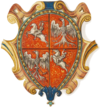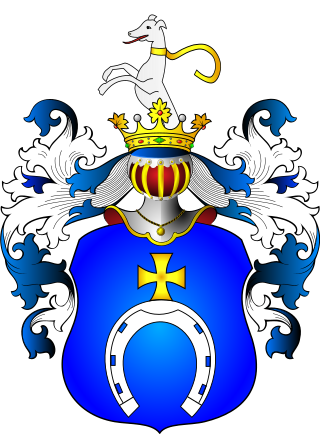
The House of Koniecpolski is the name of an old and once powerful Polish noble family.

Jelita is a Polish coat of arms. It was used by several szlachta families.

Trąby is a Polish coat of arms. It was used by many szlachta (noble) families under the Kingdom of Poland and the Polish–Lithuanian Commonwealth.

Druck is a Polish coat of arms. It was used by several Szlachta (noble) families under the Polish–Lithuanian Commonwealth.

Geysztor or Gieysztor is a Polish coat of arms. It was used by several Szlachta families in the times of the Polish–Lithuanian Commonwealth.

Polish heraldry is the study of the coats of arms that have historically been used in Poland and the Polish–Lithuanian Commonwealth. It treats of specifically Polish heraldic traits and of the Polish heraldic system, contrasted with heraldic systems used elsewhere, notably in Western Europe. Due to the distinctive ways in which feudal societies evolved, Poland's heraldic traditions differ substantially from those of the modern-day German lands and France.

Mogiła is a Polish coat of arms. It was used by a number of szlachta (noble) families under the Polish–Lithuanian Commonwealth.

Łuk is a Polish coat of arms. It was used by several szlachta families under the Polish–Lithuanian Commonwealth.

Niesobia, is a Polish coat of arms. It was used by several old szlachta families in the times of the Polish–Lithuanian Commonwealth.

Hełm is a Polish coat of arms. It was used by a number of szlachta (noble) families under the Polish–Lithuanian Commonwealth.

Drużyna is a Polish coat of arms. It was used by several szlachta families in the times of the Kingdom of Poland and the Polish–Lithuanian Commonwealth.
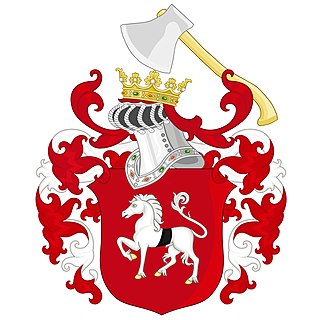
Starykoń is a Polish coat of arms. It was used by several szlachta (noble) families under the Polish–Lithuanian Commonwealth. Notable bearers of this coat of arms include Jan Wielopolski.
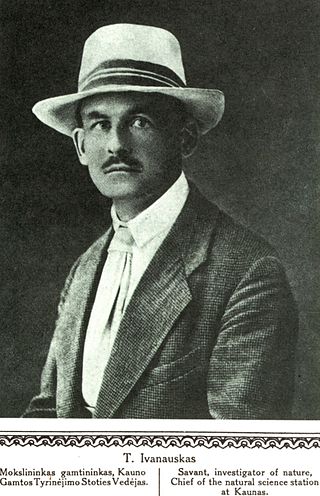
Tadas Ivanauskas was a Lithuanian zoologist and biologist, and one of the founders of Vytautas Magnus University.
Danish heraldry has its roots in medieval times when coats of arms first appeared in Europe. Danish heraldry is a branch of the German-Nordic heraldic tradition.

Dąbrowski is a Polish coat of arms. It was used by several szlachta families.
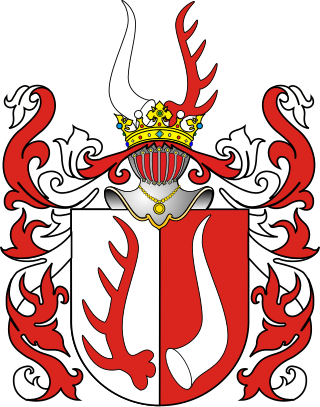
Rogala is a Polish coat of arms, likely imported from Germany to Poland in 1109 by the Rogala or the Ribersztein family, that then added the second horn. It was used by several szlachta families in the times of the Polish–Lithuanian Commonwealth.
Polish heraldry is typical to the Polish nobility/szlachta, which has its origins in Middle Ages knights/warriors clans that provided military support to the king, dukes or overlords.
Rogala is a surname. Notable people with the surname include:

The Wasielewski family is a German noble family of Polish extraction. Members of the family held significant military positions in the Kingdom of Prussia and later within the German Empire.
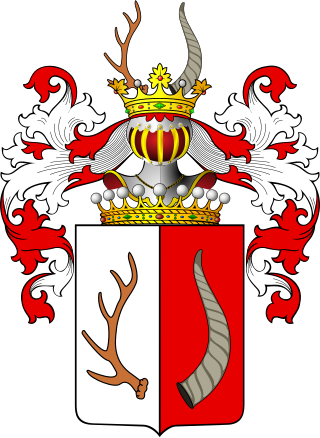
Krasicki was a Polish noble family first mentioned in the 15th century. Many Krasiccy were magnates in the First Republic of Poland.
This page is based on this
Wikipedia article Text is available under the
CC BY-SA 4.0 license; additional terms may apply.
Images, videos and audio are available under their respective licenses.

